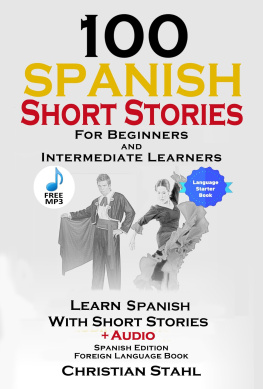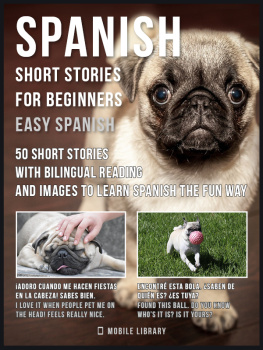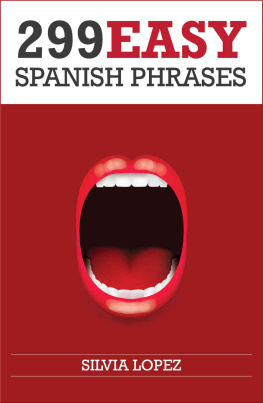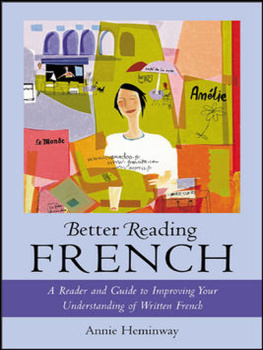Better Reading SPANISH
Second EditionJean Yates, Ph.D.


Copyright 2012 by McGraw-Hill Companies, Inc. All rights reserved. Except as permitted under the United States Copyright Act of 1976, no part of this publication may be reproduced or distributed in any form or by any means, or stored in a database or retrieval system, without the prior written permission of the publisher. ISBN: 978-0-07-177032-3
MHID: 0-07-177032-1 The material in this eBook also appears in the print version of this title: ISBN: 978-0-07-177031-6, MHID: 0-07-177031-3. All trademarks are trademarks of their respective owners.
Rather than put a trademark symbol after every occurrence of a trademarked name, we use names in an editorial fashion only, and to the benefit of the trademark owner, with no intention of infringement of the trademark. Where such designations appear in this book, they have been printed with initial caps. McGraw-Hill eBooks are available at special quantity discounts to use as premiums and sales promotions, or for use in corporate training programs. To contact a representative please e-mail us at bulksales@mcgraw-hill.com. TERMS OF USE This is a copyrighted work and The McGraw-Hill Companies, Inc. (McGraw-Hill) and its licensors reserve all rights in and to the work.
Use of this work is subject to these terms. Except as permitted under the Copyright Act of 1976 and the right to store and retrieve one copy of the work, you may not decompile, disassemble, reverse engineer, reproduce, modify, create derivative works based upon, transmit, distribute, disseminate, sell, publish or sublicense the work or any part of it without McGraw-Hills prior consent. You may use the work for your own noncommercial and personal use; any other use of the work is strictly prohibited. Your right to use the work may be terminated if you fail to comply with these terms. THE WORK IS PROVIDED AS IS. McGRAW-HILL AND ITS LICENSORS MAKE NO GUARANTEES OR WARRANTIES AS TO THE ACCURACY, ADEQUACY OR COMPLETENESS OF OR RESULTS TO BE OBTAINED FROM USING THE WORK, INCLUDING ANY INFORMATION THAT CAN BE ACCESSED THROUGH THE WORK VIA HYPERLINK OR OTHERWISE, AND EXPRESSLY DISCLAIM ANY WARRANTY, EXPRESS OR IMPLIED, INCLUDING BUT NOT LIMITED TO IMPLIED WARRANTIES OF MERCHANTABILITY OR FITNESS FOR A PARTICULAR PURPOSE.
McGraw-Hill and its licensors do not warrant or guarantee that the functions contained in the work will meet your requirements or that its operation will be uninterrupted or error free. Neither McGraw-Hill nor its licensors shall be liable to you or anyone else for any inaccuracy, error or omission, regardless of cause, in the work or for any damages resulting therefrom. McGraw-Hill has no responsibility for the content of any information accessed through the work. Under no circumstances shall McGraw-Hill and/or its licensors be liable for any indirect, incidental, special, punitive, consequential or similar damages that result from the use of or inability to use the work, even if any of them has been advised of the possibility of such damages. This limitation of liability shall apply to any claim or cause whatsoever whether such claim or cause arises in contract, tort or otherwise.
Contents
Preface
Better Reading Spanish has been developed for English speakers who have a basic to intermediate knowledge of Spanish and is designed to help them read Spanish better and to encourage them to read more.
To read better, we must read more. As an encouragement for beginning readers, I have organized this book according to eight areas of interest: cuisine, music, sports, cinema/theater, art, family, contemporary lifestyles, and history/politics. At least one of these areas should interest the reader immediately, and after that subject is explored, interest in another will follow. The selections include material that has appeared in newspapers, magazines, books, brochures, and flyers, as well as on the Internet. In addition to recipes, essays, poems, book excerpts, and songs, there are original articles appearing in print for the first time. Some of the online selections have been abridged and edited for accuracy.
Selections not otherwise credited were compiled, adapted, or created by the author. While each sections material relates to a topic in Hispanic culture, the section as a whole is not intended to be an overview or summary of the topic. Instead, the selections have been chosen for their broad appeal, their variety, and their likelihood to inspire readers to explore new horizons and to feel confident as they encounter the written word in Spanish in its myriad forms. Each section begins with selections that are easiest to read, although none of the material has been simplified. The selections become progressively more difficult within each section, and each section ends with a selection written by a contemporary Spanish or Latin-American author who has received critical literary acclaim. Each reading selection is followed by one or more exercises designed to help readers develop skills in understanding what they are reading.
The overall goal is to help readers develop reading strategies that will help them understand and benefit from future reading material. If we can read better, we will read more.
How to use this book
One of the joys of reading is that you can read what you want, when you want, however you want. The format of
Better Reading Spanish enables you to use, and benefit from, the book in different ways. One approach is to select a topic that interests you, read each of the selections in order, writing the exercises after each one, until you have completed the final, most difficult selection. If you are really interested in this topic, you will probably be able to read the final selectionbecause you want to and because you have been developing important reading skills that make the material easier to read.
Then you may choose another topic that interests you. A second approach is to read the first, easiest selection in each section, writing the exercises as you go, then progress to the second selection of each section, and so on until you have completed the most difficult selections in the book. In your approach to an individual selection, first read it in its entirety, then proceed with the exercises, which are designed to help you read without the aid of a dictionary. The exercises encourage development of the following skills: Skimming for general meaning: reading the entire selection quickly to determine its general purpose and content Scanning for details: noting headings, references, and other guides to quick information Using word formation to determine meaning: knowing how prefixes, suffixes, verb endings, and grammatical forms indicate meaning Using cognates to determine meaning: comparing Spanish words with related words in English Using context to determine meaning: making educated guesses about the meaning of unfamiliar words by determining their role in the context of a sentence, paragraph, or entire selection Learning idioms and other expressions: recognizing and learning the meaning of forms that cannot be translated literally Understanding artistic expression: recognizing literary devices that authors use Rereading for comprehension: reading an entire selection again to gain greater understanding
Using a dictionary








 Copyright 2012 by McGraw-Hill Companies, Inc. All rights reserved. Except as permitted under the United States Copyright Act of 1976, no part of this publication may be reproduced or distributed in any form or by any means, or stored in a database or retrieval system, without the prior written permission of the publisher. ISBN: 978-0-07-177032-3
Copyright 2012 by McGraw-Hill Companies, Inc. All rights reserved. Except as permitted under the United States Copyright Act of 1976, no part of this publication may be reproduced or distributed in any form or by any means, or stored in a database or retrieval system, without the prior written permission of the publisher. ISBN: 978-0-07-177032-3